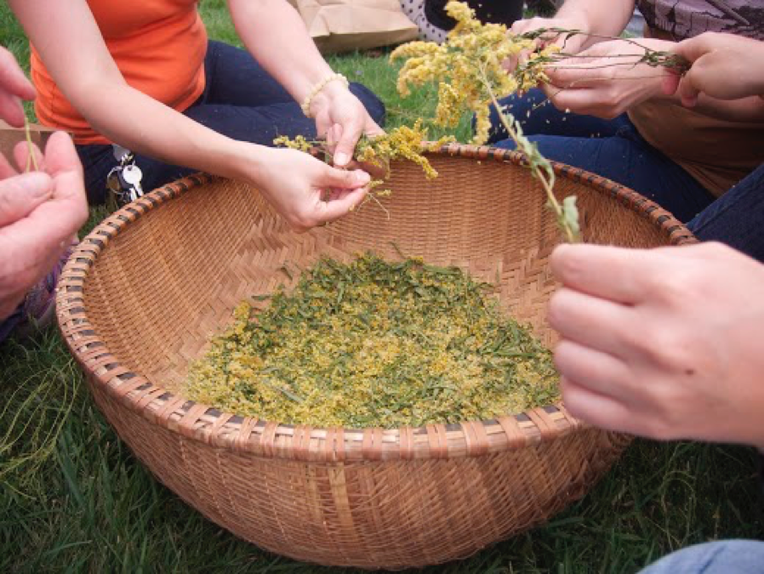Care
From the Series: Lexicon for an Anthropocene Yet Unseen
From the Series: Lexicon for an Anthropocene Yet Unseen

I propose care as a methodological mode of attention that can ground the sometimes frightening implications of the Anthropocene as an epoch. Care as a method helps shift the overwhelming largeness of the spheres—bio, strato, litho—toward more intimate and personal relationships with the Anthropocene as an emergent quality of the natural/cultural world. A good working definition of care highlights the cultivated body-knowledges and sensibilities by which creatures come to attend to one another’s needs. The creatures I draw in here are teachers of western herbalism, their students, and the plants they work with. Their modes of learning care across biological difference can offer a response to the suggestion that problems of the Anthropocene—global climate change, plastics in the ocean, pharmaceuticals in the water supply, the potential collapse of global ecologies—are too big to cope with.
My research has dwelt in spaces where North American herbalist practitioners take seriously clinical and biochemical understandings of medicinal plants, as well as understandings based in plant spirit medicine—a term that frames plants as complexly active beings with whom humans can partner in easing suffering. Their practices of care include not only attention to suffering human bodies in clinical and informal settings; they also include active maintenance of nurturing relationships with plants in local gardens, fields, and unmanaged forests. Herbalists think critically and carefully about global flows of medicinal plants and their parts in markets for herbal medicines, attending to the ecologies and labors of plants (and their harvesters) in places that many of them will never visit. Such varied practices of care help enable forms of intimacy with bite-sized chunks of the biosphere in a moment called the Anthropocene, so that we might better digest its import and demands.

In Garden Apprenticeship class, we’ve all just arrived at one of the gardens. Scattered quiet through the beds and pathways, each of us sits with a plant for fifteen minutes. Wormwood, motherwort, comfrey, lady’s mantle, elecampane, black cohosh, schisandra: medicine plants have their human companions, sitting, listening, watching. Some reach out to touch and hold a part of the plant, a stem, a leaf—like holding hands with a friend—and some just sit quietly. Companioning plants like this helps herbalists learn to listen well to them, to get down to plant time, to prepare themselves to work and learn alongside plants in the garden.
We are asked to learn more deeply from direct encounter with plants themselves. The plants become beings for us, palpable as creatures and potential active collaborators insofar as we ingest and sit with them. These practices shift our encounter with the world. Sitting with plants slows the heart rate, the breathing. Lips part to inhale the dense scent of the loam and the plant itself, to exhale a gift of CO2 in what herbalist Susun Weed calls a “giveaway dance with the plants.” Eyes closed, our fingers stroke the plant and in one way or another, new understandings ensue. Through becoming intimate and perhaps animate in partnership with plants, herbalists learn how to care for a world beyond that of human suffering. Without our care, in anthropocenic contexts, some medicine plant ecologies deteriorate. Without their care for humans—their molecular and spirit abilities to attend to human bodies—our capacities for health falter.
For the herbalists who use it, plant time is a learned shifting of bodily sensibility. It takes intentional cultivation of a different sense of time for late-capitalist humans to move into the vegetal pace of breathing with a plant, and it is this cultivation that enables collaboration with and care for plants. Getting down to plant time becomes an embodied and temporally shaped mode of caring across biologies. This mode is especially pertinent in a moment of climate change and massive human impact on the planet. Some herbalists locate the beginnings of human and planetary healing in the recognition that humans are not outside of the natural world. In order to help others become well, herbalists and their vegetal others have to coordinate across complexly embodied webs of relationship within nature and across different experiences of temporality. This can mean working across a human experience of sped-up late industrial time and a plant’s annual or years-long cycles of germination, growth, and death.
An herbalist who wanders into the garden or out of the city to gather plants in less managed woods, field, desert and swamp, bends or reaches and slows down to greet the plant, asking permission to harvest some of its parts. He or she often leaves an offering, a gift, in return for the gift of the plant’s medicine. Visiting burdock, dandelion, or black cohosh, herbalists make room for the plant’s be-ing, beyond its usual object status. Caring across biologies emerges as a bodily practice through such exchanges. By attempting to move into plant time, herbalists construct a fleshly, embodied mode of attending that shifts their human perception and proprioception. Plants as beings become intimately palpable, emerging as a kind of kin to care for.
Herbalists’ intentionally intimate and embodied relational practices help articulate how and why plant-human relationships matter. Such practices understand plants as beings occupying a different mode of time, and as capable of coordinating with humans to enable care across entangled biologies and social ecologies of wellness and illness (see Craig 2012; Nading 2014). They offer us the chance to think more broadly about who can care for whom and how, rather than falling into the seductive traps of projected human victimhood that thinking with the Anthropocene so often offers (Dean 2016). This is carework not in terms of ocean levels or parts per million, although those articulations of the biosphere’s assemblages help to tell stories about why intimate forms of care are necessary. Rather, this care happens at the vegetal pace of affective and embodied relation across domains of experience. Care across biological difference can enrich the possibilities that the Anthropocene as a conceptual framework offers us, while also helping us thrive in its context.
Craig, Sienna R. 2012. Healing Elements: Efficacy and the Social Ecologies of Tibetan Medicine. Berkeley: University of California Press.
Dean, Jodi. 2016. “The Anamorphic Politics of Climate Change.” e-flux, no. 69.
Nading, Alex M. 2014. Mosquito Trails: Ecology, Health, and the Politics of Entanglement. Berkeley: University of California Press.